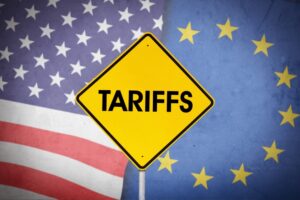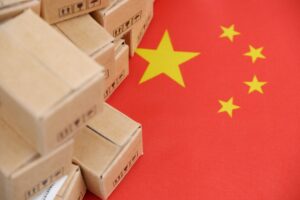The Economic Impact of Trump’s Tariffs on Europe: An Initial Assessment

President Donald Trump’s tariffs clearly pose a profound challenge to the global rules-based trading system, marking a huge shift after decades of multilateral trade liberalisation that had left tariffs at near-historic lows. The economic impact on the European Union is much less clear, however. Evidence on the possible economic effects of Trump’s tariffs suggests that the macroeconomic consequences for the EU could be significant but manageable and fear of trade diversion from China is likely exaggerated.
The transatlantic tariff wall
The EU and US do not have a free trade agreement (FTA) and until now have traded under the most-favoured nation (MFN) tariffs they offer to all World Trade Organisation members…
Before the trade war, the average US tariff rate on imports from the EU was 1.47 percent, while on EU imports from the US it was 1.35 percent. Based on 2023 trade volumes, full implementation of Trump’s tariffs would raise the average tariff rate on imports from the EU to 15.2 percent. Most of this comes from the 20 percent ‘reciprocal’ tariff on most products (9.7 of an increase of 13.7 percentage points), while tariffs on steel and aluminium (1.4 percentage points) and vehicles (2.6 percentage points) contribute relatively little. Tariff exemptions at time of writing for some goods (mainly pharmaceuticals and electronic products such as smartphones) reduce the average tariff rate somewhat.
Trump’s 9 April announcement of a 90-day pause on full implementation of some of these tariffs has reduced the rate on most products from the EU to 10 percent. Tariffs on steel, aluminium and vehicles remain in place. As long as the pause lasts, the average bilateral tariff is estimated to be 9.9 percent, or an 8.4 percentage point hike compared to 2023.
04/17/2025 | Madalena Barata da Rocha, Nicolas Boivin & Niclas Poitiers | Bruegel
Why the New Growth Chapter for EU Manufacturing Is Set to Be a Slow Burn

The following is an excerpt:
Just as a new growth phase seemed to be inching closer, European manufacturing is now facing a new era of trade turmoil. A longstanding decline in industrial production across the region emerged in the first quarter of 2023 – but just as we’ve started to see it bottoming out, US President Donald Trump’s tariffs have taken the sector by storm.
Rising levels of trade uncertainty are now intensifying the pressure on both low confidence levels and a limited willingness toward investment, and this is bad news for goods-producing sectors like manufacturing. 20% reciprocal tariffs have been postponed for 90 days, but 25% tariffs on steel, aluminium, cars and auto parts remain in place for now. Most other EU-manufactured goods are now subject to a 10% tariff.
Still, February saw production in both the EU-27 and the eurozone rising to the highest level since August last year on the back of American frontloading. Improved purchasing power could translate into stronger consumer spending after a weak first quarter, but that more positive picture is now being clouded by tariff tensions and the weakening economic environment, both of which are seriously weighing on confidence.
…On a more positive note, international trade has often shown resilience. In contrast to the direct effect of less trade with the US, there is a good chance that European exporters could be successful in shifting part of their trade from the US to other countries.
The EU is actively pursuing new trade agreements and partnerships with countries such as Mexico, Chile, Switzerland, Malaysia and the Mercosur states. In the longer term, this could provide some counterbalance to the new trade obstacles, and in turn, we could see the longer-lasting effects proving limited.
The large tariff differences will also make Europe a relatively cheap alternative to China for American importers. Despite the limited overlap between European and Chinese exports to the US, this could boost goods exports to the US, as the EU appears competitive in some product groups that match. But the escalation of the trade war between the US and China will also have a negative effect on EU manufacturing as China seeks markets outside the US for its state-supported exports. The outcome of these developments is difficult to predict, if only because of the constantly changing trading conditions.
05/01/2025 | Edse Dantuma | ING THINK
The Road to a New European Automotive Strategy: Trade and Industrial Policy Options

Nicolas Köhler-Suzuki, one of the authors of this paper, is a featured speaker at WITA’s upcoming European Trade Policy Update. Learn more here.
The European automotive industry stands at a crossroads, facing three concurrent challenges: decarbonizing to tackle climate change, maintaining global competitiveness in a fierce market, and safeguarding economic security amid rising geopolitical tensions. At the heart of the European economy, the automotive sector directly employs 1.4 million people and supports 13 million jobs indirectly across the EU, with implications extending far beyond the industry itself. The transition from internal combustion engine vehicles (ICEs) to electric vehicles (EVs) presents profound challenges, as structural adjustments to production processes and supply chains will significantly affect European employment and economic prospects.
The EU has established a legislative framework for transport sector decarbonization, and the automotive industry has invested substantially in this transition. However, evolving market conditions have created a trilemma of competing objectives: decarbonization, competitiveness, and economic security. Successfully navigating this transition requires a unified yet adaptable European strategy that addresses trade-offs between the objectives, balances short-term priorities with medium- and long-term investments, and coordinates action between private and public sectors.
Each aspect of the trilemma presents both opportunities and challenges for the automotive sector, its supply chain, and the broader European economy. Addressing these issues comprehensively will require coordinated international trade and industrial policies.
The EU aims to achieve 100% zero-emission mobility for all new vehicles by 2035, in line with its commitment to climate neutrality by 2050. This target requires substantial investment in EV infrastructure, battery production, and consumer incentives. However, EV adoption rates vary significantly across member states, creating an uneven transition.
Key challenges include high costs and consumer hesitancy. EVs remain significantly more expensive than comparable ICEs, limiting widespread adoption. Inadequate charging infrastructure and high electricity prices create additional barriers. Europe must also scale up battery production to compete with China’s dominance of the global battery supply chain.
01/27/2025 | Victor do Prado, Elvire Fabry, Arancha González Laya, Nicolas Köhler-Suzuki, Pascal Lamy & Sophia Praetorius | Jacques Delors Institute
Why 2025’s Q1 Shocks Could Be the Last Opportunity to Forge an EU Master Plan

The following is an excerpt:
The EU and the second Trump administration
Despite all the warnings, the EU and the European Commission were not ready for Trump’s return. The EU reacted late to both President Trump’s provocations and those of his incoming administration. This applies to territorial claims (particularly over Greenland) and interference in EU domestic matters. And this is still happening now, with one potent example being the warnings given to European firms that they need to be aligned with the US administration’s anti-DEI policies if they want to participate in US government procurement.
Winding the clock back a little, many of the provocations made by Trump and his eventual administration against the EU and some of its Member States started as early as November 2024, in the immediate aftermath of the US elections. When the administration took office, it very much continued its anti-EU rhetoric. The first tariff announcement came on 3 March with a 25% tariff on steel and aluminium imports. This led to an immediate (but also the first formal) response from the Commission, with swift and proportionate draft countermeasures on US imports into the EU.
There have been attempts to react more strongly against American interference, for example in the German federal election and ongoing investigations under the EU Digital Services Act (DSA). Indeed, regarding the latter, a letter signed by 12 EU Member States, including Germany, led to the announcement that ongoing DSA investigations would continue apace. On 23 April, multimillion fines were announced by the Commission against Apple and Meta, with action against X (formerly twitter) still planned.
05/02/2025 | Karel Lannoo | Centre for European Policy Studies (CEPS)
Chinese Exports to U.S. Plunge Along With Smartphone Shipments

First Impact of U.S. Tariffs
Chinese shipments to the U.S. plummeted 21% year-on-year in April as the impact of Washington’s new import tariffs started to punish the world’s largest exporter.
However, as Beijing was quick to point out, China compensated by selling more to its economic partners in Southeast Asia. In a striking coincidence, Chinese exports to the ASEAN bloc of countries increased by the same number: +21%.
The decline in shipments to the U.S. is the first time that China has reported a significant harmful impact of the tariffs. In the first quarter, exports to the U.S. continued their rise as manufacturers and shipping companies rushed goods into ports before the expected duties took effect.
Eager to temper the market’s worries about a severing of the trade relationship between the world’s top two economies, diplomats are meeting in Switzerland in an attempt to secure a new agreement about trade terms. The outcome is certain to be higher tariffs than a decade ago, but officials are wary of triggering a recession.
Focus: U.S.
The focus of the April data release was, of course, shipments to the U.S. Exports to the U.S. plummeted 21% to $33 billion. The preliminary data form does not break out exports per individual country. But the biggest drop in exports among significant consumer goods was in mobile phones: Shipments dropped 20.9% to $7.6 billion. The number of handsets shipped fell 5.8% to 56.1 million. However, overall of high-tech goods rose 6.9% to $74.7 billion.
Overall exports of toys declined 5.9% to $2.9 billion. Exports of textiles rose 3.4% to $12.6 billion. Exports of mechanical and electrical products jumped 10.5% to $190.6 billion.
05/09/2025 | John W. Miller | Trade Data Monitor
WITA – We put the community in trade community.
Information about upcoming WITA and trade community events


